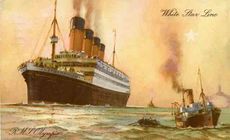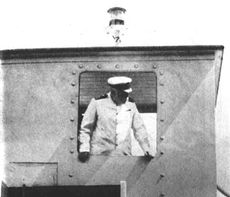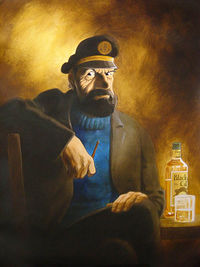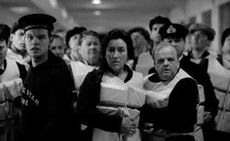RMS Olympic
“Why does that bugger not sink?”
– White Star
“Haddock of the RMS Olympic? Good, we've got a cartoon captain”
– White Star
“Man, those stripes will dazzle the Jerries”
– Lloyd George
RMS Olympic is known as the ship her owners and crews tried to sink - but failed everytime. The Olympic should have ended up at the bottom of the ocean with her sister ships RMS Titanic and HMHS Britannic but somehow the Olympic never delivered. Four times the crew nearly succeeded but each time the other vessel came off worse. It's a remarkable sailing record and in the wake of Titanic, largely forgotten except by men pretending to be sailors in the comfort of their padded libraries.
Construction
In 1908 the White Star shipping line were locked in a battle of the seas with rivals Cunard and two German companies Norddeutscher Lloyd and Hamburg America Line. The idea was to build ships big enough to take human cargo[1] to North America, cater for those who wanted to pay extra for comfort and gambling and to finally be the fastest ship to cross the Atlantic. Cunard had their liners like the Mauretania and the Lusitania whilst the German owned ships were getting involved too with their steel leviathans. White Star wanted to be part of this and came up with their trio of super liners: RMS Olympic, RMS Titanic and RMS Britannic. What no one knew at the time, the ships were built deliberately to sink - or be sunk - so that White Star could collect the insurance money[2]. This also the reason why so few lifeboats were provided either, to minimise the number of survivors and litigants. In maritime law then you could claim damages if you were alive. The dead or their families couldn't sue.
The 46,000 tons RMS Olympic was the first to be built at the Belfast Harland and Wolff shipyard in Belfast. It was quickly pressed into service by White Star as the 'latest in liner technology'. In fact the ship was constructed from thousands of rivets rather than the more modern welding technique. At the time White Star said they 'didn't have time' to retrain the work force. This suggests they were unwilling to spend any more money on the ship either and also the reason they equipped it and the RMS Titanic with a pathetic number of lifeboats.
White Star had a back up plan. They put out the message that the Olympic and Titanic were 'unsinkable' and so didn't need well qualified seamen to work on them. The ships were said to be 'so simple' than even an idiot could navigate them. And if they couldn't find enough idiots to man the ships, arrogant captains who thought they knew better would be better. Step forward Edward John Smith, captain first of the Olympic and then Titanic's first - and last- skipper. He impressed right away.
Hawke Collision
Olympic's first attempt to sink was on 20th September 1911 when it collided with the British warship HMS Hawke off the coast of the Isle of Wight. The Olympic was still able to make it back to port with three compartments flooded and a twisted propeller. At the inquiry into who caused the HMS Hawke accident was blamed to Olympic because she had very powerful suction which made HMS Hawke slam into the side of the ship. The captain onboard this was Captain Edward John Smith. Considering the damage, the Olympic should have gone down but the Hawke was just slightly too small to have made enough of an impact to have sunk the ship. Hawke was repaired but never the same ship again and was sank by a U-Boat early in the First World War.
Considering the damage, Smith should have been busted down to tugboat duties but mysteriously he was allowed to remain captain. At an enquiry Smith claimed the Hawke should have got out of the way and was channel lane hogging. Since Smith made a far better impression than the Royal Navy, he was cleared[3]. Nine months later the Olympic had a 'screw go loose' (this time not Smith but the method of propulsion used then) and returned to Belfast for a repair, just as the Titanic was about go on her first voyage. Considering his less that stellar performance so far, White Star gave Smith command of the Titanic for her maiden voyage. Evidently despite two attempts, the Olympic was still afloat. Smith would be more useful on a different ship.
The Titanic Disaster
On 14th April 1912, now under the command of another man called Captain Herbert James Haddock (the inspiration for Tintin's Captain Haddock), the Olympic got involved in the Titanic disaster. When the distress signal came through, Captain Haddock offered to steam back to help her sister ship. Considering that an iceberg had just fatally holed the Titanic and was in area where other icebergs had been reported, this looked like kamikaze sailing on a ship with a known weakness for sinking.[4].
Following the sinking of the Titanic, the Olympic was put back into Harland and Wolff to 'strengthen her bottom' and add a few lifeboats, in fact re-using Titanic's and painting out the name and replacing it with Olympic. However perhaps someone who wasn't in on the insurance scam ordered Olympic to have an an inner watertight skin was constructed and heightening the bulkhead divisions. In effect the Olympic was double bottomed and built as strong as any ship in the Royal Navy. This extensive rework was also extended to the RMS Britannic - or least that was the official story. What wasn't been made clear was that the British naval authorities had plans to turn all their liners into auxiliary armoured cruisers - something the Germans were already doing with own super liners. This was soon proved to be what happened in World War One.
Audacious Sinking
War is never good for cruise ships but for White Star this offered a new opportunity. It could lease the Olympic and her new sister Britannic, just freshly completed. The Royal Navy gladly took over the Britannic, renamed her the HMHS Britannic and put that vessel into war duties. However the Olympic was a less attractive proposition, for despite it's modifications after the Titanic disaster was considered to be an inferior vessel. Reluctantly White Star were forced to maintain their cross Atlantic trade in a time when people were wishing to travel only one way - from Europe to America. Only war junkies wanted to head in the opposite direction.
So it is believed the owners of the Olympic came up with a plan right out of Catch-22. They would get the Germans to sink the Olympic for them. Sailing times were sent via a neutral country and leaked to the German High Command. Since Germany had already decided the British owned Cunard ships were carrying munitions across the Atlantic, they seemed sure White Star were doing the same with their ships. This was made public in October 1914, all British owned liners were to be treated as enemy vessels and that any neutral on them better had Anti-Mine or U-Boat insurance.
The Olympic made it's last voyage as a civilian ship in October 1914. According to the secret plan, it should have run into mines or U-Boats in the waters around Southern Ireland. However the British admiralty forced the Olympic to change their sailing plans and go north instead. The Germans only had one mine layer up in that part of British waters (disguised as a trawler) and it was told to 'chuck as many mines in the sea as you can'. However it wasn't the Olympic that had found these mines but the brand new battleship HMS Audacious which was in the area testing out their engines and hornpipe drill. By the time the Olympic arrived, the Audacious was in a bad way and it's crew taken off. The Audacious sank shortly after but such was the shock about losing a prize new asset, the British government ordered a news black out. All British passport holders on the Olympic were warned of dire consequences if they said or reported anything but this couldn't apply to a band of noisy American tourists. They were planning to spill all when they got to New York, and remarkably, had photos and film of the Audacious sinking. Since White Star knew also, the British government struck a deal with White Star. They would take on the Olympic after all. For White Star this was a good outcome: they had offloaded two floating white elephants in a time of war. The Royal Navy listed the Audacious as still afloat and on active service until the end of the war.
U-Boat Ramming

For the first time since they had built the 'super three', White Star were at last in profit. Now they weren't too bothered if the Olympic or the Britannic ever came back. Well in the case of the Britannic this turned out to be true when she sank in November 1916 off the coast of Greece. Trying to beat the record set by the Titanic, the Britannic sank in an hour. It's victims being not passengers but crew, nursing staff and patients on what was now a hospital ship. Since there were no icebergs involved, the sinking was blamed (depending on what you read), sabotage (either from Germany, Turkey or the Irish in revenge for the Easter Uprising), a mine or a torpedo. That the Britannic crew were none too bright either (White Star's Back Up plan in operation), it could have been there fault or a submerged shopping trolley. Whatever, it seemed the Olympic class liners still had an affinity with sinking without explanation.[5] Then came news that White Star wasn't looking forward to: Germany was losing World War One. This meant the Olympic, now painted in a psychedelic razzle-dazzle livery to show the British were heavily into drugs, would be returned. The owners weren't looking forward in cleaning it up and ejecting all the drug addicts on board (medical staff) or the state of the toilets after it had ferried 200,000 American and British Commonwealth troops across the ocean for the previous four years.
Looking for another Captain Foolhardy who could be guaranteed to deliver the Olympic to Davy Jones locker, the ship's new captain Bertram 'Let Me Have a Go At 'Em' Fox Hayes was put in charge. Since her change to military service, the Olympic had been fitted with guns to fire on enemy vessels. When told there was a U-boat dead ahead, instead of zig-zagging away, Hayes ordered his ship to charge at U-boat 103. This should have been no contest, a couple of torpedoes should have sunk the Olympic and head butting a solid built German underwater vessel should have resulted with the same outcome. However for once Germans steel bent first and it was the U-boat that took the fatal hit. The Olympic's ultra re-strengthened double bottom had done its work[6]. What an iceberg could do to the Titanic in 1912, a U-boat couldn't repeat the feat on the Olympic in 1918.
Times Good and Bad
The battered Olympic was returned to White Star and put into dock for a full conversion back to a luxury liner. During repairs, a large dent below the waterline was discovered. It was later shown this had been made by a torpedo but that it hadn't detonated. This indeed was a lucky ship compared to her beautiful and but fated sister ships. White Star for now gave up trying to sabotage their own ship. During the 1920s the Olympic enjoyed a boom in customers, all keen members of a Titanic societies who loved to travel on a ship that was the near identical. Some tried to have 'lifeboat parties' on the Olympic but these were usually stopped in time.
The economic downturn in the 1930s in the Great Depression now made travelling by big liners the preserve of the rich. A few years earlier in 1924 the American government imposed severe immigration restrictions (except the Irish) for anyone coming into the USA. In addition, the Olympic was looking a bit old fashioned in size and shape, despite regular internal makeovers. This all affected the bottom line and talks of a merger between White Star and Cunard meant they had too many ships. The Olympic was marked down for possible destruction but at scrap value, it wouldn't fetch much. Perhaps, an an echo of their earlier treatment of the Olympic, perhaps the 'Old Girl' could take one for the company and get involved in another naval disaster (and insurance claim). How about running her aground somewhere?
Nantucket Lightship LV-117
For years ships of all sizes had passed by the Nantucket Lightship, just south of the Nantucket Shoals off the coast of Massachusetts. It was a ship all vessels saw as the approached New York Harbor. It was in effect a floating lighthouse, though not very high in the water but considered bright enough that no one could miss her unless they meant it. Well in May 1934 the Olympic said they didn't see it and ran straight into the ship as it was trying to crash into the shoals. At least that was the unofficial explanation. The official explanation suggested thick fog, people mixing up their coordinates and sheer bloody mindedness. May be once again White Star's maritime recruitment standards were still blame 25 years on from the initial plan. In this instance the 7 of the Lightship's crew were killed. The damage on the Olympic was small and easily fixed. After that White Star gave up and went ahead with a full merger with Cunard.
Compared to other ships of her vintage, the Olympic was still in good condition and if had it survived to World War Two, it may well have got through that war too and come out the other side. However the ship was sold in 1935 for scrap and eventually reduced to a saved interiors, some panelling and rivets by 1937. The secret story of how White Star tried to sink their own ships remains obscure to this day but the list of accidents
Olympic Conspiracy Theories
The biggest conspiracy theory is that the Olympic was the ship that sank in April 1912 and not the Titanic. It was claimed that the Olympic was such a wreck after the Hawke collision that White Star knew it could never be fixed properly and so arranged to have it found somewhere out in the North Atlantic as the Titanic. An iceberg hit was as a good as any other and the owners knew Captain Edward Smith had a habit of colliding with other vessels. So the real Titanic was the ship everyone knew as the Olympic from April 1912 onwards. The theory here is that all the White Star liners were meant to sink as a massive insurance scam but that through accidents, bad luck, unexpected developments (a World War) and insane naval heroics conspired to save the Olympic each time. It was only finally destroyed by men tearing it up for scrap in a dry dock. Why? because of Sheena Easton, that's why.[7]. It doesn't sound at all heroic but through base instincts, greed, stupidity, pig headedness, a ship can survive. The epithet 'Unsinkable' was true after all. It was just applied to the wrong ship...or was it?
References
- ↑ Cargo that paid for the honour this time.
- ↑ White Star always denied this was what they intended to do but the facts suggest otherwise.
- ↑ The official record says White Star were found guilty. Strangely Smith wasn't sacked even then.
- ↑ That Haddock was so willing to fling his ship into the path of other icebergs goes to show White Star were trying to go for the 'double' as regards the loss of the Titanic and Olympic.
- ↑ So much for all the extensive rework on the Britannic whilst it was being modified. Perhaps someone wasn't telling the truth.
- ↑ Evidently not everyone was in on the insurance scam.
- ↑ Now you may think what is an obscure reference to a wee Scottish singer and her sugar walls have as connection to the history of the Olympic. And you would be damn right. None at all. It's just that I was reminded this article had no sex in it, so a name plug for an old squeeze of Prince was just the ticket. OK, back to the story.








